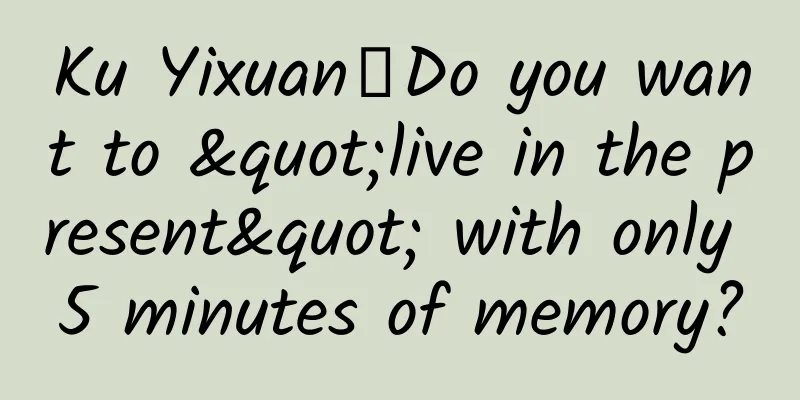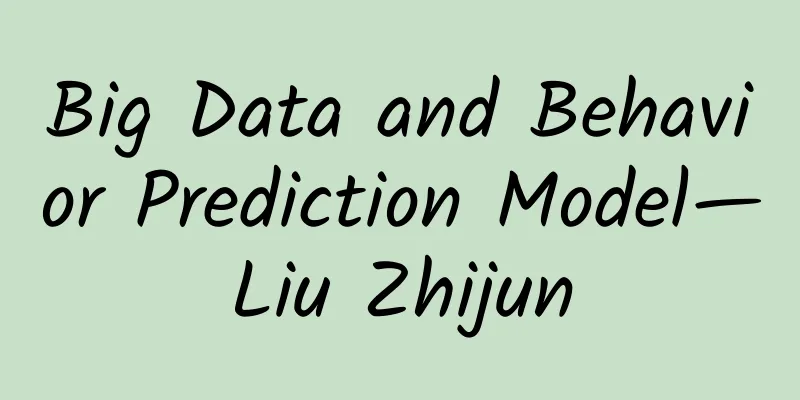Ku Yixuan丨Do you want to "live in the present" with only 5 minutes of memory?

|
"Imagine if we didn't have a hippocampus. We wouldn't be able to form new long-term memories, but we would still have short-term memories, so we would become people who live in the present moment." Ku Yi Xuan Professor of Psychology, Sun Yat-sen University Hello everyone, I am Ku Yixuan, from Sun Yat-sen University. Today I want to share with you the stories about memory and emotions. First of all, I want to ask you a question: Do you remember what you had for lunch last Sunday? This question seems difficult. Let me ask you another question. What is the most unforgettable thing in your life? You may quickly think of the so-called four great joys in life, as well as the sad events we have witnessed together. Why do these great joys and sorrows make us remember them so deeply? This is what we are going to discuss with you today. Do you want to “live in the present” with only 5 minutes of memory? Just as the wound heals after we get hurt, but then it itches again, and you keep wanting to scratch it; the same is true for painful memories. In the dead of night, painful memories emerge, and we may be unable to fall asleep. In severe cases, they may even lead to post-traumatic stress disorder and mental problems. These painful memories are so unforgettable, so is there a way to eliminate them? Men in Black I don’t know if you have seen "Men in Black". In this movie, the agents will use memory erasure. With a flash of light and a "click", the memories of the people around them for a period of time will disappear, and they will not remember what happened just now. But on the other hand, we will find that it is so difficult to maintain memory. Imagine that we will learn a lot of new knowledge in class. But if you don’t review it, by the time of the final exam, you will have very little memory left. Memories are fleeting, and we need to review them constantly to consolidate them. Of course, we can gradually extend the time for each review, starting with one day, then reviewing again after a month, and then reviewing again after a year. After that, the fragments that stay in our minds for a short time will form long-term memories and become difficult to forget. Memory consolidation depends on the hippocampus Why can you still remember the knowledge you learned when you were old? In fact, this is the work of a magical structure in the brain - the hippocampus, which determines the consolidation process of short-term memory to long-term memory. Imagine if people didn't have hippocampus, what would happen? Then we couldn't form new long-term memories, but we still had short-term memories, so we would become people who live in the present. Nowadays, everyone is very fashionable and pursues the feeling of "living in the present". But in history, there was indeed such a person who lived in the "present". Henry Molaison (1926–2008) In the 1950s, there was a patient named Henry Molaison, codenamed "HM" before his death. HM had epilepsy since childhood. When he had an attack, he would foam at the mouth and his hands would twitch, which was life-threatening. So the doctor found the location in his brain that caused epilepsy and removed it. This place was the hippocampus. You can see from the above pictures that the normal brain in the right picture is full, while the hippocampus on both sides of HM's brain in the left picture has been removed, leaving it empty. What problems will arise after the hippocampus is removed? After losing the hippocampus, people cannot form long-term memories, but their IQ is normal Doctors found that his intelligence was normal, even higher than the average IQ of ordinary people. Doctors asked HM to recall his childhood, such as who was the president of the United States in a certain year, and he could remember clearly. But HM could not form new memories. He could not recognize the doctors and nurses who operated on him. Of course, he could recognize them again, but he would forget them again after five minutes. These stories are written into the plots of movies. For example, in "Memento" and "50 First Dates", there are such plots, and the protagonists need to repeatedly meet friends and relatives. You can think about this feeling of "living in the present", do you want it? The next question is: What do emotions mean to us? Amygdala In the 1990s, another very famous patient named SM appeared. She lost part of her brain due to phospholipid protein deposition disease. The missing brain area is called the amygdala, which is a small area located in front of the hippocampus like an almond. Normal control (left) and SM (right) You can see from the MRI that SM's amygdala is missing. After losing this brain area, she became fearless compared to normal people. Many people like to watch horror movies because they want to challenge themselves, but SM is different. She feels interesting, curious, and excited when watching horror movies, but she doesn't feel the fear that most people feel. SM lost her fear, but she still has other emotions. We Chinese have an old saying called "seven emotions and six desires", including joy, anger, sorrow, fear, love, hate and desire. The doctor did a test and asked her to draw basic emotions, such as happiness, anger, sadness, disgust and surprise. She had no problem drawing them, but she couldn't draw fear. If she had to draw fear, she could only draw the image in the lower left corner, a child crawling with his hair standing up. This is what she understands as fear. Fear of loss brings her some unexpected characteristics, such as friendliness. Most people keep a distance when socializing, except for the closest people. When we talk to others, we always keep a relative distance. We have an old saying called "looking at each other in dismay", but SM does not have this problem. Even if she is face to face with others at a very close distance, she will not feel awkward. The lack of fear also caused her a lot of trouble, because she didn't feel afraid at all. When facing knife-wielding and gun-wielding gangsters several times, she was still fearless and almost died because of it. We can see that in the basic emotional classification, negative emotions are much more numerous than positive emotions. Of course, different emotions have their driving forces, which are the modes we rely on for survival. Positive emotions are the driving force for us to do things, but these negative emotions are also very important abilities that we have evolved. For example, fear can keep you away from danger, disgust can keep you away from poisonous food, anger can establish equal relationships between people, and sadness can bring people closer together. So although negative emotions make us uncomfortable, they are very important in the evolutionary process, and losing any of them is not acceptable. So, how do emotions affect our memory? Simply put, it is the interaction between the two areas we just talked about - the hippocampus and the amygdala. For example, most people are more impressed by horror movies than documentaries. Why? Researchers conducted an experiment in which they asked subjects to watch a new movie and then tested how much they could remember. The bar graph on the right below is the test result. We can see that the red box shows the test process of playing a horror movie first and then a documentary. In this process, the memory accuracy of the two movies is not much different, and is relatively higher than the others. The blue box shows the test process of playing a documentary first and then a horror movie. The memory accuracy of the horror movie is higher than that of the documentary. The dark blue box shows the test process of playing two documentaries. The memory accuracy of both movies is relatively low. The results showed that when playing the same documentary, if a horror film was played first, the subjects' emotions would be aroused and their relative memory would become better. Why does such emotional arousal lead to memory enhancement? The study found that in the red and blue frame situations, the connection between the human hippocampus and amygdala is relatively stronger. The negative emotions generated by the subjects enhance the effect of the amygdala on the hippocampus, so our memory becomes more profound. We now know that emotions affect the consolidation process of short-term memory to long-term memory, which is an effect of the amygdala on the hippocampus. So to answer the previous question, when short-term memory has not yet been consolidated, will emotions affect the formation of memory? This is what our laboratory focuses on. The first step is to develop a tool to measure short-term memory. How much do you think your short-term memory capacity is? Let's try it out. In ten seconds, see how many numbers you can remember. In fact, this string of numbers is pi - 3.1415926535897932384. When it comes to memorizing numbers, most people can remember an average of 7, some can remember up to 9, and some may only remember 5, so this is the upper limit of short-term memory capacity. Since the average capacity is 7, let's do a line test. There are 6 lines here in total. Please pay attention to their directions. Next, let's determine whether the graph has changed. If it has, which line has changed? Most people may not notice the change, but the direction of the line in the lower left corner has changed. We can conclude that if it is image memory, our encoding strategy will be limited and it will become more difficult to remember. At this time, our short-term memory capacity is actually only 4±1, and we can only remember about 4 line directions. Why does the brain have so many neurons but can only remember so little information in a short period of time? This is an open question and there is no answer yet. Studies have found that the brain areas involved in short-term memory storage are many areas of the cerebral cortex, including the prefrontal cortex, parietal cortex, occipital cortex, etc. Frontal lobe (left), parietal lobe (center), and sensory cortex (right) The red bright spots are the areas activated when our short-term memory is active. After the brain acquires the information of short-term memory, it will be consolidated back to our cortex through the hippocampus to form long-term memory. This is the consolidation process from short-term memory to long-term memory. So, when will the capacity of short-term memory reach its limit? As you can see, the line graph on the right shows the change in the capacity of short-term memory. When we memorize one object, the activity of our parietal cortex is the blue line. If we memorize two objects, the line of activity of the parietal cortex will be larger and become a green line. If we memorize three objects, the activation will further increase and become a red line. However, when there are more than four objects, the line of activity of the parietal cortex will be difficult to continue to increase. At this time, the capacity of our short-term memory has reached the upper limit and we can no longer remember more objects. This may be a key factor in limiting memory capacity, but is there a causal relationship between brain activity and behavior? Every day we hear roosters crowing and see the sun rising, but can we say that the roosters crowing caused the sun to rise? Only when there is no rooster and the sun does not rise, can we prove the causality. We have done experiments to stimulate the parietal cortex to see if we can change memory capacity. Our latest research results show that electrical stimulation of the parietal cortex can increase short-term memory capacity, and it seems that activity in the parietal cortex does limit short-term memory capacity. Parietal cortex determines short-term memory capacity Everyone knows that multiple-choice questions are easy, while fill-in-the-blank questions and short-answer questions are more difficult. If I ask you to recall a knowledge point, is it more difficult to write it down? Then we can go one step further and ask, what determines the accuracy of memory? How do we measure the accuracy of memory? Let's take the same test question again. This time you need to fill in the missing line in the circle in the upper right corner. The accuracy of each person's recall is different. If you remember, it will form a Gaussian distribution around the correct value (von Mises distribution on the circumference). If you forget, you will randomly choose, which will form a uniform distribution. So, we can measure the accuracy of memory through this behavior pattern. Where is the brain representation of this accuracy measurement? We let the subject lie in the functional magnetic resonance imaging to complete the test while recording his brain activity. LOC activity determines memory accuracy We can see that the stronger the activity of the lateral occipital complex (LOC) in the occipital lobe of the brain, the more accurate the memory measured by behavior. Furthermore, by combining machine learning methods with functional magnetic resonance imaging (fMRI) measurements, we can decode the memory representation curve. Why do we need to do this? Once we have determined the traces of memory and the form of memory representation, we can further change it. In animal studies, researchers have been able to locate the specific location of memory cells and what their discharge patterns are like. Scientists are also using some optogenetic and molecular biochemical methods to try to rewrite memories. Perhaps, in the future, light that can eliminate specific memories may also appear in humans. How do emotions affect short-term memory? With the above method, we can measure it. We first let the subjects look at a group of photos, some of which are positive emotions and some are negative and terrifying, and then let the subjects complete the line test task. Negative emotions affect the accuracy of short-term memory Then we found that when we remember 2 or 4 things, we can complete it very well, and emotions have no effect. As shown in the bar chart above, Load2 and Load4 show that the three columns of neutral, negative, and positive emotions are similar. But if the things we need to remember exceed our memory capacity limit, for example, we need to remember 6 things, what should we do? At this time, we found that negative emotions can actually improve the accuracy of the subjects' memories. Both positive and negative emotions increase amygdala activity Why is this so? Magnetic resonance imaging studies have found that both positive and negative emotions can increase the activation of the amygdala. Only negative emotions enhance short-term memory representation However, through near-infrared experimental data, if we use machine learning methods to look at the changes in memory representation during the whole process, only negative emotions can make memory traces stronger. The interactive relationship between emotion and short-term memory In our study, we also found that the emotional network (areas such as the amygdala and insula) has a significant impact on the activity of the memory brain network (areas such as the frontal lobe, parietal lobe, and entire lobe), thereby changing our behavior. Finally, I would like to share with you Du Fu's story and poems. Du Fu's life was very tragic, he was displaced and experienced many negative emotions, but the poems he wrote were so beautiful and his observations were so meticulous. He wrote in "Spring Thoughts": "The flowers shed tears when I feel the time, and the birds startle my heart when I feel the separation." Emotions can make a person's memory deeper and more vivid. Each of us should learn to be the master of emotions and accept those seemingly negative emotions. Maybe it will bring you a positive change and make you stronger and better in some aspects. Let each of us become an emotional colorist and make our memories more vivid and beautiful. Thank you everyone! The articles and speeches only represent the author’s views and do not represent the position of the Gezhi Lundao Forum. |
<<: Why do I see strange patterns when I rub my eyes?
>>: Satellite image of the China-Laos Railway: How this "mountain and river miracle" was built
Recommend
Where is Xixia?
This is a A mysterious, long-neglected dynasty It...
Chinese research team makes Kenyan corn grow from 1 meter to 2 meters! | Expo Daily
Chinese research team, Let Kenyan corn grow from ...
Relying on LTE, Qualcomm has become the invisible "God" in the field of smartphones
In the mobile phone industry, Qualcomm is as omni...
Will QR codes be used up soon? Can genetic testing reveal your IQ? Which of these ten "scientific" rumors have you believed?
"QR codes will soon be used up", "...
As a TO B product operator with a monthly salary of 30,000 yuan, are you good at operating ERP management software?
Internet+ brings new disruptive management and bu...
Real-life and analysis of community operations
The concept of community operation is very popula...
Wuhan tea tasting recommendations
Wuhan Tea Tasting Contact Information I strongly ...
Year-end review: Major breakthroughs in Chinese science and technology in 2021
2021 is coming to an end. The past year has been ...
27 dead and 158 injured! If you find a gas leak, don't do this
Gas is our production and life An indispensable e...
8 minutes to help you quickly understand data analysis (with book recommendations)
With data analysis being so popular in the past t...
Why is the night sky so dark when there are countless stars shining in the universe? Solving the Olbers paradox
On a clear night, we look up at the sky and see a...
Google releases second Android 13 developer preview to improve notification push permission settings
In recent months, the development of Android 13 h...
Derivation and thinking of user operation system
A system is a whole composed of similar things wi...
What kind of "black technology" is needed to build a power station at an altitude of 3,000 meters?
In the Tibetan area of Ganzi, Sichuan 2 km down...
Kuaishou Advertising | How to promote on Kuaishou?
Kuaishou advertising is to place advertisements i...









